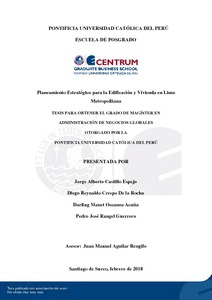| dc.contributor.advisor | Aguilar Rengifo, Juan Manuel | |
| dc.contributor.author | Castillo Espejo, Jorge Alberto | es_ES |
| dc.contributor.author | Crespo De la Rocha, Diego Reynaldo | es_ES |
| dc.contributor.author | Oscanoa Acuña, Darling Manet | es_ES |
| dc.contributor.author | Rangel Guerrero, Pedro José | es_ES |
| dc.date.accessioned | 2018-03-26T15:18:55Z | |
| dc.date.available | 2018-03-26T15:18:55Z | |
| dc.date.created | 2018 | |
| dc.date.issued | 2018-03-26 | |
| dc.identifier.uri | http://hdl.handle.net/20.500.12404/11719 | |
| dc.description.abstract | En la última década, el sector construcción ha crecido a un ritmo importante, salvo los
años 2015 y 2016 en los que decreció debido principalmente a la caída de la inversión
pública, que a su vez redujo la producción de cemento. Dentro del sector, lo que sufrió la
mayor caída fue la infraestructura; debido a la paralización de diversos proyectos públicos y a
los actos de corrupción reportados en empresas ligadas a este. La edificación de viviendas
sostenía de alguna manera que el sector no cayera aún más, actividad que continuó y no
paralizó, sobre todo impulsada por los programas del Estado, aunque no se cumplieron los
objetivos en la reducción del déficit.
El enfoque del presente trabajo, es el de desarrollar una propuesta estratégica que
contribuya al Estado en definir una serie de políticas y acciones respecto a cómo reducir
drásticamente, en un plazo de 10 años el déficit habitacional en Lima Metropolitana, tanto
cuantitativo como cualitativo; ello quiere decir que además de construir nuevas viviendas,
también se plantea mejorar, reparar, reforzar, y formalizar viviendas existentes, mejorando la
calidad de vida de la población. A partir del análisis preliminar, se concluye que para
fomentar la inversión para la Edificación y Vivienda en Lima Metropolitana, es importante
que el Estado tenga un rol activo, elabore, y apruebe leyes que activen la construcción de
viviendas; además debe fungir como un ente integrador entre el sector bancario, las
inmobiliarias y constructoras, los organismos privados y públicos, los gremios del sector, y
los usuarios y/o la población. Es de alta importancia que se definan objetivos comunes,
retadores, pero realistas y, realizar un seguimiento exhaustivo para controlar las desviaciones
y así poder garantizar que el plan se cumpla | es_ES |
| dc.description.abstract | In the last decade, the construction sector in Peru has grown at an important rate,
except for the years 2015 and 2016, where it was reduced to the fall of public investment,
which in turn reduced cement production. Within the sector, which had the biggest drop in
infrastructure, this due to the stop of several public projects and acts of corruption in
companies linked to the sector. The construction of houses maintained a way so that the
sector did not fall further, housing continues to be built, especially driven by state programs,
although the objectives in reducing the deficit have not been completed.
The focus of this work is the development of a strategy that collaborates with the
State in a series of policies and actions regarding how to drastically reduce the housing deficit
in Metropolitan Lima, both quantitatively and qualitatively, over a period of 10 years. It
means that in addition to building new homes, it also aims to improve, repair, strengthen and
formalize existing homes, improving the quality of life of the population. From the
preliminary analysis, it is concluded that to encourage investment in the secondary sector of
Building and Housing, it is very important that the State take the properties, elaborate and
learn that the property of the construction of houses, also must function as an integrator
between the banking sector, the real estate and construction companies, the private and public
organizations, the unions of the sector and the users and / or the population. It is vitally
important that common, challenging but realistic objectives are drawn up and a thorough
follow-up is carried out to control deviations and thus ensure that the plan can be met | es_ES |
| dc.language.iso | spa | es_ES |
| dc.publisher | Pontificia Universidad Católica del Perú | es_ES |
| dc.rights | Atribución-NoComercial-SinDerivadas 2.5 Perú | * |
| dc.rights | info:eu-repo/semantics/openAccess | es_ES |
| dc.rights.uri | http://creativecommons.org/licenses/by-nc-nd/2.5/pe/ | * |
| dc.subject | Industria de la construcción -- Perú -- Lima | es_ES |
| dc.subject | Viviendas -- Construcción -- Perú -- Lima | es_ES |
| dc.subject | Planificación estratégica | es_ES |
| dc.title | Planeamiento estratégico para la edificación y vivienda en Lima Metropolitana | es_ES |
| dc.type | info:eu-repo/semantics/masterThesis | es_ES |
| thesis.degree.name | Magíster en Administración de Negocios Globales | es_ES |
| thesis.degree.level | Maestría | es_ES |
| thesis.degree.grantor | Pontificia Universidad Católica del Perú. CENTRUM | es_ES |
| thesis.degree.discipline | Administración de Negocios Globales | es_ES |
| renati.discipline | 413307 | es_ES |
| renati.level | https://purl.org/pe-repo/renati/level#maestro | es_ES |
| renati.type | https://purl.org/pe-repo/renati/type#tesis | es_ES |
| dc.publisher.country | PE | es_ES |
| dc.subject.ocde | https://purl.org/pe-repo/ocde/ford#5.02.04 | es_ES |






